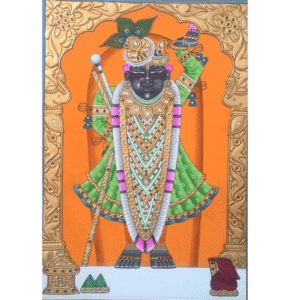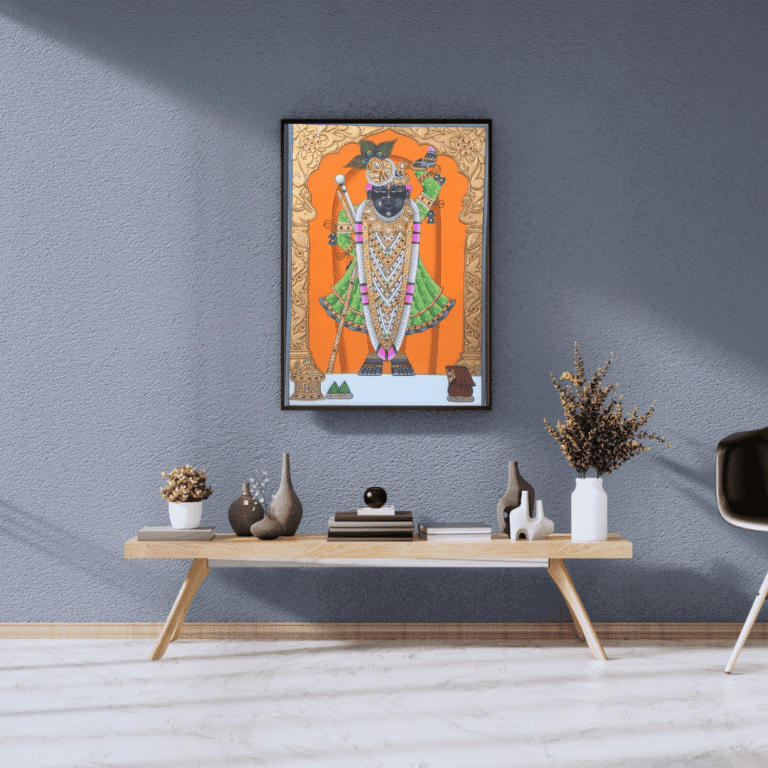Origins of Shrinathji Gold Leaf Art: From Nathdwara Temples to Modern Homes
Table of Contents
If you’ve ever stood in front of a Shrinathji real gold leaf painting, you’ll know what I mean when I say the art doesn’t just shine—it radiates. For more than three decades, I’ve had the privilege of working alongside Nathdwara and Udaipur artists who live and breathe this tradition from long-time. And every time I watch them lift a delicate sheet of gold leaf with steady hands, I’m reminded that this craft is not just about beauty—it’s devotion made visible.
In this blog, I’ll walk you through how these gold leaf painting became such a central element, and how the tradition continues to evolve in today’s homes and collections.

Main Roots in Nathdwara Temples
In General when we talk about Nathdwara, often we think of the grand temple of Shrinathji—the child form of Lord Krishna lifting the Govardhan hill. But fewer people know that this very temple gave birth to an entire school of art.
If we look Back in the 17th century, when the idol of Shrinathji was moved from Govardhan (near Mathura) to Nathdwara, a community of artists followed. These artists, deeply tied to the ‘Pushtimarg Vaishnav tradition’, began painting for the temple’s daily rituals. Their role wasn’t decorative; it was devotional.
I still remember one senior artist in Nathdwara telling me, “Hum to sevak hain, kala hamara seva hai”—“We are just servants, art is our service.” That mindset shaped everything.
Role of Pushtimarg & Devotional Tradition
In Pushtimarg, worship is not about grand temples alone—it’s about intimate, daily seva to Krishna. Paintings became an extension of this seva: backdrops for darshan, depictions of festivals, and personal images devotees could take home.
This is where the roots of gold leaf use begin. Gold was not just ornament—it symbolized purity, prosperity, and divine light. What better way to honor Shrinathji than to surround him with a glow that never fades?
Early Patronage & Royal Influence
During my early years of visit in Nathdwara, I’ve seen how much patronage mattered. The royals and wealthy devotees often commissioned gold leaf works to be gifted to the temple or displayed in their homes. The more devotion, the more intricate the painting—embossed jewelry, gem inlays, and layers of real 22k gold leaf.

Artistic Evolution Over Centuries
The earliest Shrinathji works were large Pichwais—temple backdrops filled with lotus ponds, cows, and dancing gopis. But as time passed, smaller panel paintings emerged, designed for private devotion.
Transition from Temple Walls to Portable Panels
In 18th and 19th centuries, as Nathdwara’s fame spread, devotees from across India (and later the entire world) wanted to carry a piece of darshan back home. This gave rise to gold leaf paintings on wooden panels and cloth, often framed in ornate makhar (temple-style) frames.
Even today, in my Udaipur studio, I meet families who say, “Our grandparents had a Shrinathji gold leaf painting in their pooja room—it’s part of our childhood memories.” That continuity is what makes this tradition so alive.
Key Motifs & Symbolism in Early Art
If you study these paintings closely, you’ll notice recurring symbols:
- Shrinathji’s left hand raised (lifting Govardhan)
- Lotus flowers symbolizing purity
- Cows and peacocks as companions of Krishna
- Golden ornaments highlighting divine beauty
The gold leaf was carefully applied on crowns, jewelry, and thrones, giving the painting an otherworldly radiance.
From Nathdwara to Modern Homes
Today, Shrinathji gold leaf paintings are not confined to temple walls. They hang in modern apartments in Mumbai, homes in New Jersey, and even corporate offices that want a touch of spiritual elegance.
Influence on Collectors & Global Audience
In the 1990s, I saw the first wave of international collectors visiting Udaipur studios. They were fascinated not just by the craft but by the living tradition behind it. Unlike museum relics, these paintings are still being created by the same families of artists, generation after generation.
Revival Studios in Udaipur & Rajasthan
Many young artists are now blending tradition with subtle contemporary touches—cleaner backgrounds, muted palettes, or minimalist framing. But the essence remains the same: gold leaf as a medium of devotion.
Why Gold Leaf Became Central
Gold isn’t chosen only for its shine. In Indian devotional thought, gold represents immortality, divine aura, and abundance. By placing Shrinathji in a golden halo, artists ensured that the darshan never loses its sanctity.
Symbolism of Gold in Devotion
Gold attracts positive energy. In paintings, it becomes a visual metaphor for Krishna’s eternal glow.
Artistic Durability & Prestige
There’s also a practical side. Real 22k gold leaf doesn’t tarnish easily. I’ve seen 200-year-old works where the gold still glimmers, even if the pigments have faded. This permanence makes gold leaf not just a decorative choice, but a mark of prestige.
Conclusion – Preserving Tradition in Modern Times
As I worked with Nathdwara artists for over 30 years, I can say this confidently: Shrinathji gold leaf paintings are more than art—they are living devotion. From temple rituals to modern living rooms, their journey tells us how faith, craft, and beauty can endure across centuries.
And perhaps that’s why, whenever a new collector asks me, “Should I invest in a gold leaf painting?” my answer is always the same: “You’re not just buying art—you’re becoming part of a tradition.”
They originated in the 17th century in Nathdwara temple as part of Pushtimarg devotion and later spread into homes.
Pichwai paintings are large temple backdrops, while gold leaf panels are often smaller, focused depictions of Shrinathji.
Gold symbolizes purity, divinity, and eternal light—making it ideal for Krishna’s iconography.


